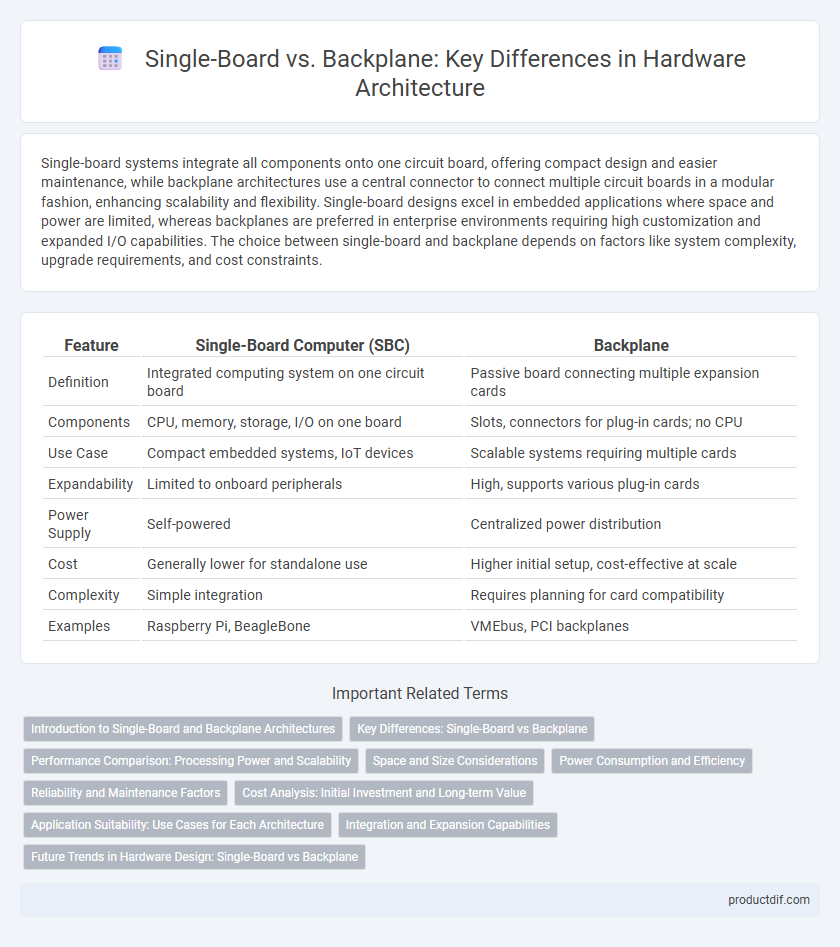Single-board systems integrate all components onto one circuit board, offering compact design and easier maintenance, while backplane architectures use a central connector to connect multiple circuit boards in a modular fashion, enhancing scalability and flexibility. Single-board designs excel in embedded applications where space and power are limited, whereas backplanes are preferred in enterprise environments requiring high customization and expanded I/O capabilities. The choice between single-board and backplane depends on factors like system complexity, upgrade requirements, and cost constraints.
Table of Comparison
| Feature | Single-Board Computer (SBC) | Backplane |
|---|---|---|
| Definition | Integrated computing system on one circuit board | Passive board connecting multiple expansion cards |
| Components | CPU, memory, storage, I/O on one board | Slots, connectors for plug-in cards; no CPU |
| Use Case | Compact embedded systems, IoT devices | Scalable systems requiring multiple cards |
| Expandability | Limited to onboard peripherals | High, supports various plug-in cards |
| Power Supply | Self-powered | Centralized power distribution |
| Cost | Generally lower for standalone use | Higher initial setup, cost-effective at scale |
| Complexity | Simple integration | Requires planning for card compatibility |
| Examples | Raspberry Pi, BeagleBone | VMEbus, PCI backplanes |
Introduction to Single-Board and Backplane Architectures
Single-board architecture integrates all essential components such as CPU, memory, and I/O interfaces onto one compact circuit board, optimizing space and simplifying system design. Backplane architecture utilizes a passive or active backplane to connect multiple circuit boards, enabling modularity and scalability in complex hardware systems. Understanding these architectures is critical for selecting appropriate hardware platforms based on performance, expandability, and application requirements.
Key Differences: Single-Board vs Backplane
Single-board systems integrate all components such as the processor, memory, and input/output interfaces on a single printed circuit board, enabling compact design and simplified installation. Backplane architecture separates the backplane, which provides the electrical connectivity through slots, from the individual plug-in cards each performing specific functions, allowing for modular expansion and easier maintenance. Key differences include the single-board's all-in-one design versus the backplane's modularity, with backplanes supporting scalability and customization in complex hardware setups.
Performance Comparison: Processing Power and Scalability
Single-board systems integrate processing power on a single circuit, delivering optimized performance with low latency for compact applications. Backplane architectures enhance scalability by supporting multiple interconnected boards, allowing distributed processing and system expansion without significant performance degradation. Performance efficiency depends on workload distribution, with single-board solutions excelling in dedicated tasks and backplanes offering superior flexibility for complex, scalable hardware configurations.
Space and Size Considerations
Single-board computers (SBCs) offer a compact and integrated design, minimizing the footprint and ideal for space-constrained environments such as embedded systems or industrial applications. Backplane systems, while larger, provide modularity and scalability by allowing multiple plug-in cards, which increases overall system size but enhances customization and maintenance. Space optimization favors SBCs for tight enclosures, whereas backplanes are suited for rack-mounted or larger setups requiring flexible expansion.
Power Consumption and Efficiency
Single-board systems typically consume less power due to their integrated design, optimizing efficiency for compact applications. Backplane architectures, while offering modularity and expandability, often incur higher power consumption from multiple connected cards and additional cooling requirements. Efficiency in single-board systems is enhanced by centralized power management, whereas backplane setups require distributed power regulation, impacting overall energy usage.
Reliability and Maintenance Factors
Single-board systems offer higher reliability due to integrated components and fewer connection points, reducing the risk of hardware failure. Backplane systems, while more modular and scalable, require regular maintenance to monitor connectors and individual cards for potential faults. Proper airflow and dust management in backplane designs are critical to maintaining long-term operational stability and minimizing downtime.
Cost Analysis: Initial Investment and Long-term Value
Single-board systems typically require a lower initial investment due to their integrated design, minimizing hardware and cabling costs. Backplane architectures, while more expensive upfront due to modular components and chassis, offer superior long-term value through easier scalability and reduced downtime during upgrades. Evaluating total cost of ownership reveals that backplane solutions provide better ROI for large, evolving projects despite higher initial expenditures.
Application Suitability: Use Cases for Each Architecture
Single-board computers excel in compact embedded systems, IoT devices, and industrial automation due to their integrated components and low power consumption. Backplane architectures suit modular and scalable systems such as telecommunications, data centers, and high-performance computing where several cards or blades need interconnectivity and easy upgrades. Selection depends on specific application requirements for flexibility, expansion, and processing power.
Integration and Expansion Capabilities
Single-board systems offer high integration with all components embedded on one circuit board, enabling compact and efficient designs ideal for space-constrained applications. Backplane architectures excel in expansion capabilities by providing a modular framework where multiple plug-in cards or modules connect via a central bus, allowing easy scalability and customization. This contrast highlights single-board's optimization for compact integration versus backplane's strength in flexible, high-capacity expansion.
Future Trends in Hardware Design: Single-Board vs Backplane
Future hardware design trends emphasize the growing adoption of single-board systems due to their compactness and integration capabilities, supporting AI and edge computing applications. Backplane architectures continue evolving with advanced modularity and high-speed interconnects to accommodate scalable data center and telecommunications infrastructures. Innovations in materials and signal integrity enhancements drive both single-board and backplane platforms toward higher performance and energy efficiency.
Single-board vs Backplane Infographic

 productdif.com
productdif.com